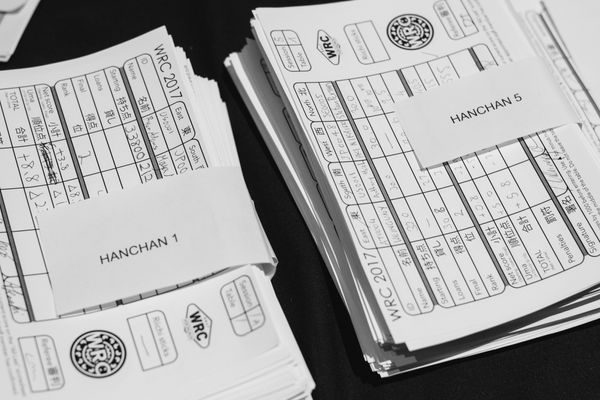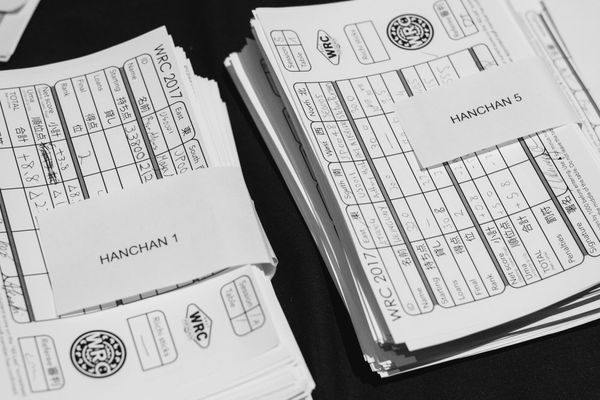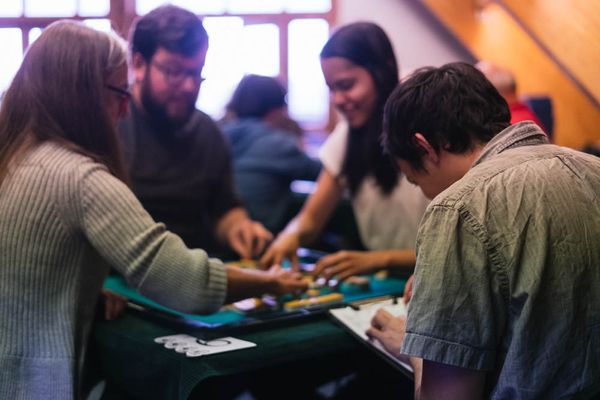Tile History - The <em>honours</em>
It’s time for the last tile history (more like Kanji history, right?) entry. We’ve the honours left: 三元牌 (Sangenpai), or the Dragons, and 風牌 (Kazehai), or the Winds. Important tiles, I’m sure you’ll agree with, but surprisingly hard to find solid information about. Also, I’ve been away for a couple of years, so excuse me if I’m not being my miserable self.







TACOS edit: Here’s the preceding article in the series for those who want to catch up on this – Tile History – The man suite
中
The shell and bone version was a flagpole with fluttering banners, the pole piercing the centre of the frame. Meaning “inside” or “throughout” or “including” (or even “the mean”). It can also mean “hit”; at least as a hanzi. It’s named “chuu” in Japanese.
發
Named “hatsu” (or “hotsu”) in Japanese. Its meaning is “issue”, “dispatch”, “send out” or “emit”. There are two simplified forms, 发 and 発, but we don’t care about no simplified forms. What’s interesting is that it is what’s known as a “phono-semantic compound”; from semantic 弓 (“bow”) + phonetic 癹 (“sound of bowstring when shooting”).
白
Even more information from our oracle bones. Originally it showed an acorn, the colour white is from the acorn’s meat. The original meaning is lost (compare with 自 – originally “nose”, now “self”). Meaning is “white” or “pure” or “unblemished”. It can also mean “innocence.” It’s named “Haku” in Japanese, at least with the Kan’on reading.
Now, you might think that’s not very interesting at all, not like with the numbers where you actually learned something (maybe not useful, but at least as trivia). 發財 (“fācái”) means “Get Rich” or “wealth” or “to make a fortune.” 白版 (“báibǎn”) means “clean slate” or “freedom from corruption”. These tiles are, in Chinese mahjong, called 箭 (“jiàn”), and they represent archery. In ancient Chinese archery, you’d put a red 中 for a hit. White would represent failure (it makes sense — a target that’s not been hit would be unblemished, but more logically would be the mandarin meaning “in vain”), and 發 just means that the draw was released. Awesome, so we’ve archery in our mahjong.
Let’s move on to the winds instead.
東
Phonetic borrowing – originally represented a bag tied at both ends (like a cellophane-wrapped candy with the ends twisted), and was later borrowed phonetically to mean “east”. In historical usage it means “eastern Japan”. The traditional (although incorrect) etymology of this was that it was the sun (日) rising behind a tree (木). “Ton” is probably a bastardization of pinyin’s “dōng” (in Wades-Giles it’d be “tung”).
南
Shell and bones show a hut or small storehouse. However, seal inscription style shows grass shoots and boundaries (屮+冂) combining an inverted 入 pierced by two horizontal lines which gives a meaning of “within.” SIS therefore indicates sprouts places in a hothouse for cultivation, which leads to “south” (the direction associated with warmth and also the direction which hothouses were positioned). “Nan” is the reading in both Japanese (several different readings) as well as pinyin (nán).
西
Oh, opinions differ on this one. Shell and bone depicts a basket or colander; a physical object that remains even after the stream of water in which it is being washed disperses, “west” being an extended (or borrowed) meaning. However, some claim that it’s an ideogram of a bird settling in its nest, and by analogy the sun setting in the west. It’s been found on both shell and bones, bronzeware inscriptions and seal inscriptions (S/B, BIS, SIS). It’s got a minor meaning of “the Pure Land”, since Buddhism entered China from lands in the west. The present form of the character comes from BIS and SIS. “Shaa” or “xia” (I honestly forgot what people call it, but I remember seeing anime subtitles with “xia”) probably come from pinyin “xī”
北
Again we find our first records of this from shell and bones. It shows two people standing, back to back, prepared to leave, each in his own direction. North, go northward, flee. In Japanese its reading is either “hoku”, “hai” or “kita”. We find its usual name in hanzi instead, where it’s read as “pei” (pei3 or pei4 in Wades-Giles, “běi” (bei3) or “bèi” (bei4) in pinyin).
Right, so anyway, I’m too lazy to properly mark this with citations and everything, so take it with as much salt as you will. The most interesting discussion is probably West; Lindqvist claims that it’s a basket/colander, while Wieger and Howell are arguing that it’s a bird and by extension the sun (sun setting over the horizon).



